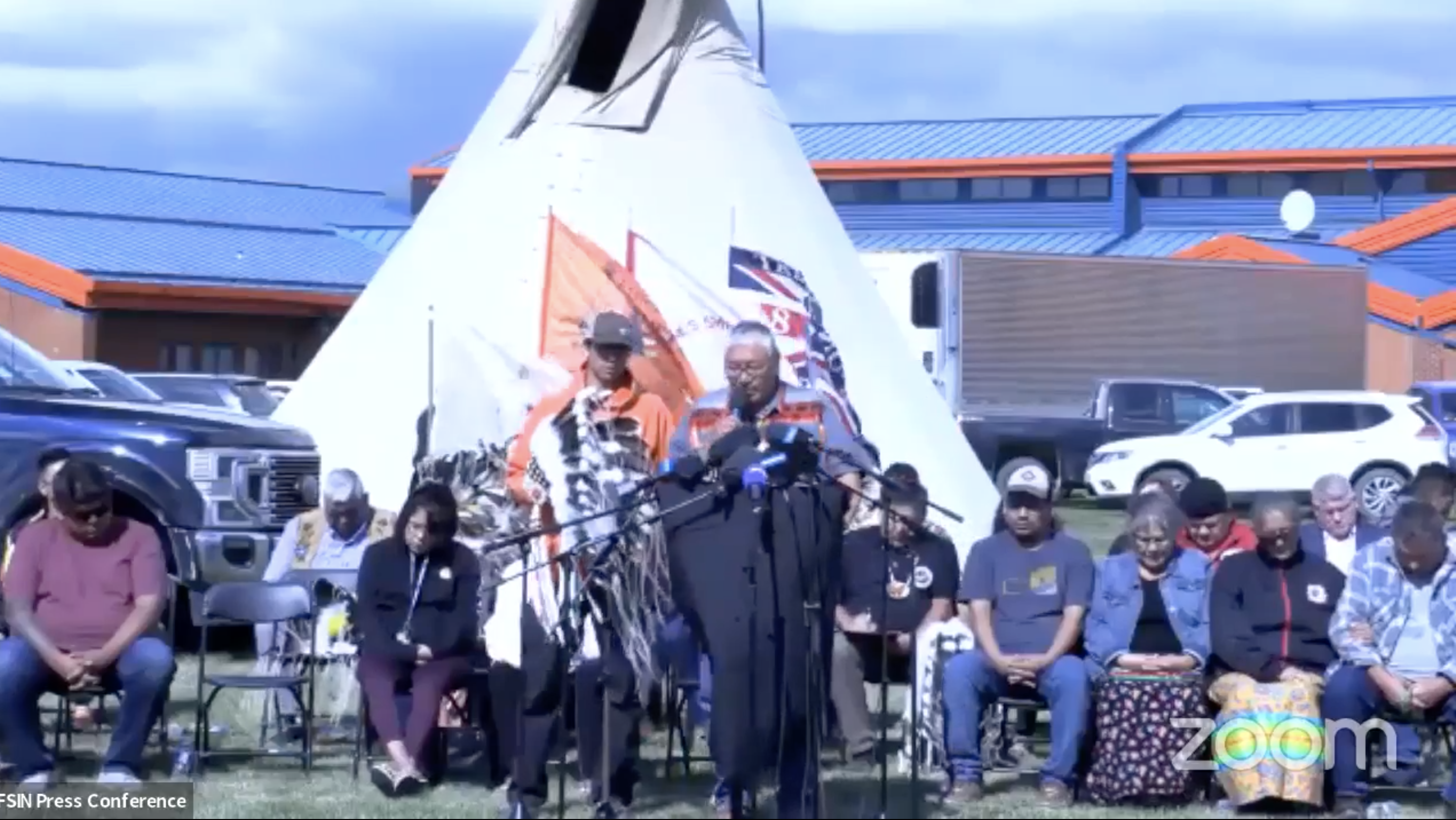At a press conference this afternoon, leaders of the James Cree Nation spoke publicly for the first time about the mass murder of 10 people on and near the reservation in Saskatchewan, Canada.

Indigenous leaders, Canadian government officials, the Royal Canadian Mounted Police, and members of the victims’ families were in attendance.
On Sunday, Sept. 4, brothers Myles and Damien Sanderson reportedly went on a deadly stabbing spree in 13 separate locations throughout the James Smith Cree Nation and in the nearby village of Weldon.
The Saskatchewan Coroner’s Service yesterday confirmed the names of all 10 victims — nine of whom were citizens of the James Smith Cree Nation. An additional 19 people were injured, including one as young as 14 years old, though their identities were not released.
During today’s live streamed news conference, the leaders of the three First Nations communities on the reserve — Chief Wally Burns of James Smith Cree Nation, Chief Robert Head of Peter Chapman Band, Chief Calvin Sanderson of Chakastaypasin — said they personally lost family members, demonstrating how close-knit the community is, and how pervasive the loss.
“No words can emphasize the feelings that we're going through,” Chief Burns said. “My nephews lost their father—my best friend. My family on the left lost their sister. These acts of violence have to stop, and they have to stop now.”
Many blamed the attacks on rampant addiction issues on the reserve. To stop the violence and protect Indigenous communities, there needs to be more awareness of addiction and the introduction of more drugs and alcohol treatment centers on Indigenous lands, Burns said.
“We can avoid this,” Chief Head said on Thursday, echoing Burns’ sentiment. “We need First Nations tribal police. We need First Nations justice systems. We need support for mental health. We need addiction centers. These are some of the things that we can address together.”
The youngest of the victims was 23 years old. The oldest was the only non-tribal member killed, 78-year-old Wesley Petterson of Weldon, Saskatchewan.
Six of the victims shared the same surname, though the local coroner’s service said they won’t be confirming any relationships of the individuals identified. Those individuals include: 23-year-old Thomas Burns; Carol Burns, 46; Gregory Burns, 28; Lydia Gloria Burns, 61; Bonnie Burns, 48; Earl Burns, 66.
One of the victims, Robert Sanderson, 49, shared the alleged killers’ last name, though it’s not clear there was any relationship.
Two additional victims appear to have been related to one another: Lana Head, 49, and Christian Head, 54.
The suspects in the murders — brothers Damien Sanderson, 31, and Myles Sanderson, 30, of the James Smith Cree Nation—have both since died. Damien was found dead by police on Sept. 5, and authorities said they are looking into whether his brother killed him.
Myles Sanderson was taken into police custody two days later, after police said they believed he sustained some injuries. He died in police custody the same day, after experiencing “medical distress.”
Grand Chief Brian Hardlotte of Prince Albert Grand Council said this atrocity is an example of the criminal systems failing Indigenous communities.
One of the alleged attackers, Myles Sanderson, was released by a parole board in February and has been wanted by police since May for violating conditions related to his release. He had 59 convictions, with an extensive list of violent crimes such as assault and robbery. He faced three counts of first-degree murder, one count of attempted murder, and one count of breaking-and-entering.
“The justice system needs to work with our members, our leaders of our First Nations, and establish – in this case – a transition period for those dangerous offenders that are within a system,” Hardlotte said.
Law enforcement officials say a motive is not yet known as to what motivated the killing spree.
The James Smith Cree Nation is composed of three communities, the James Smith Cree Nation, the Peter Chapman First Nation and Chakastaypasin First Nation. The Nation has a population of about 3,412, with the on-reserve population estimated to be at 1,892 members
More Stories Like This
Native News Weekly (August 25, 2024): D.C. BriefsUS Presidents in Their Own Words Concerning American Indians
Flanagan Calls ICE Agents ‘out of control’ after Woman Killed in Minneapolis
American Indigenous Tourism Association Announces New Board Members
Deb Haaland Talks Youth, Jobs and Opportunity in Governor Bid
Help us defend tribal sovereignty.
At Native News Online, our mission is rooted in telling the stories that strengthen sovereignty and uplift Indigenous voices — not just at year’s end, but every single day.
Because of your generosity last year, we were able to keep our reporters on the ground in tribal communities, at national gatherings and in the halls of Congress — covering the issues that matter most to Indian Country: sovereignty, culture, education, health and economic opportunity.
That support sustained us through a tough year in 2025. Now, as we look to the year ahead, we need your help right now to ensure warrior journalism remains strong — reporting that defends tribal sovereignty, amplifies Native truth, and holds power accountable.
 The stakes couldn't be higher. Your support keeps Native voices heard, Native stories told and Native sovereignty defended.
The stakes couldn't be higher. Your support keeps Native voices heard, Native stories told and Native sovereignty defended.
Stand with Warrior Journalism today.
Levi Rickert (Potawatomi), Editor & Publisher


